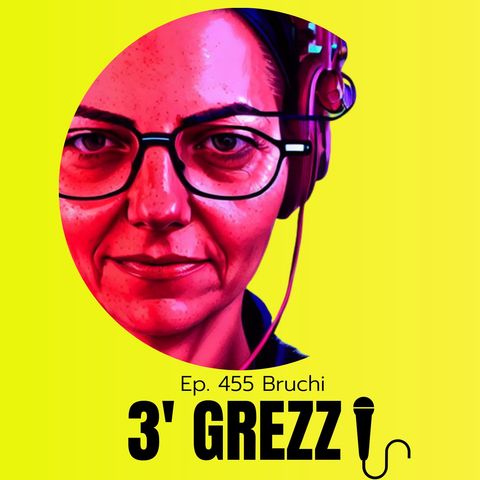3' grezzi Ep. 455 Bruchi

Scarica e ascolta ovunque
Scarica i tuoi episodi preferiti e goditi l'ascolto, ovunque tu sia! Iscriviti o accedi ora per ascoltare offline.
3' grezzi Ep. 455 Bruchi
Descrizione
Trasformazioni magiche che sembrano uscite da una di quelle spaventosissime favole dei Fratelli Grimm. L'umile bruco nasconde un mondo meravigliosamente terrificante. E sapete come si chiama un gruppo di bruchi...
mostra di piùTRASCRIZIONE [ENG translation below]
Vi avevo anticipato qualche giorno fa che avevo un bruco che mi girava per la testa e adesso bruco, vi do. Parliamo infatti dei lepidoptera, questo è il nome scientifico dei bruchi, i bruchi che da sempre sono stati usati per rappresentare la trasformazione, il passaggio da uno stato all'altro. Anzi no, non i bruchi. I bruchi non piacciono a nessuno, a quanto pare. Diciamo che è la farfalla che viene usata come simbolo di trasformazione, anche se non tutti i bruchi diventano farfalla, infatti alcuni diventano farfalla e altri diventano falene, però hanno in comune delle caratteristiche che, se una persona va a spulciare, sono incredibilmente interessanti e anche poco conosciute e cose che io non sapevo.
Ho scoperto solo quando mi sono addentrata nel mondo dei lepidopteri che, essendo una latina, forse il plurale sarà lepidopterae, non lo so, non ho studiato latino, anzitutto i bruchi sono più o meno ciechi, vedono solo la luce, ma non riescono né a distinguere le immagini né a distinguere i colori. E fin qua vabbè, ci sta. Hanno sei paia di occhi, non hanno denti, ma ci sono un sacco di animali che non hanno denti, nemmeno le tartarughe hanno denti ma hanno delle mandibole potentissime. Sono degli insetti pieni di muscoli, hanno 4000 muscoli, e se pensate che non siano tanti, pensate che gli esseri umani ne hanno 650 invece i bruchi ne hanno quasi dieci volte più di quanto non ne abbiamo noi.
Ma la cosa interessante del bruco, che io non sapevo, è che come avviene la trasformazione? Si sa, i bruchi nascono, sono delle larve, nascono, mangiano un sacco, mangiano più di 1000, crescono più di 1000 volte le loro dimensioni quando diventano bruchi adulti e poi si formano un bozzolo, il bozzolo che poi, porelli, vengono ammazzati per usare quel bozzolo, alcuni di loro, quelli che sono i bachi da seta, però quando il bruco si rinchiude dentro il bozzolo, cosa succede? E lì avviene la trasformazione. La cosa terribile è il modo in cui avviene la trasformazione. Praticamente il bruco si auto digerisce, si mangia completamente. Se voi doveste aprire un bozzolo, quando è in fase di trasformazione, ci sarebbe dentro una sostanza gommosa, che è quello che rimane del bruco che si è digerito. La cosa geniale però è che il bruco non si digerisce completamente, rimangono solo alcune cellule che si chiamano cellule immaginative, un nome fantastico. Sono specie di cellule staminali di noi esseri umani, quindi a partire da queste cellule immaginative, si crea la farfalla. Non è fantastico?
TRANSLATION
I anticipated to you a few days ago that I had a caterpillar running around in my head, and now caterpillar you get. Indeed, we are talking about lepidoptera, this is the scientific name for caterpillars, the caterpillars that have always been used to represent transformation, the transition from one state to another. Actually, no, not the caterpillars. No one likes caterpillars, apparently. Let's say that it is the butterfly that is used as a symbol of transformation, although not all caterpillars become butterflies, in fact some become butterflies and some become moths, however, they have in common characteristics that, if a person goes to poke around, are incredibly interesting and also little known and things that I didn't know.
I found out only when I got into the world of lepidoptera that, being a Latin word maybe the plural will be lepidopterae, I don't know, I didn't study Latin. First of all, caterpillars are more or less blind, they only see light, but they can neither distinguish images nor colors. And so far whatever, it fits. They have six pairs of eyes, they don't have teeth, but there are a lot of animals that don't have teeth, even turtles don't have teeth but they have very powerful jaws. They are insects full of muscles, they have 4,000 muscles, and if you think that's not a lot, think that humans have 650 while caterpillars have almost ten times as many as we do.
But the interesting thing about the caterpillar, which I did not know, is that how does the transformation takes place. You know, caterpillars are born, they are larvae, they are born, they eat a lot, they eat more than 1000, they grow more than 1000 times their size when they become adult caterpillars and then they form a cocoon, the cocoon that then, poore them, they are killed to use that cocoon, some of them, those who are the silkworms, however when the caterpillar locks itself inside the cocoon, what happens? And there the transformation takes place. The terrible thing is the way the transformation takes place. Basically, the caterpillar is self-digesting, eating itself completely. If you were to open a cocoon, when it is being transformed, there would be a gooey substance inside, which is what is left of the caterpillar that has been digested. The ingenious thing, however, is that the caterpillar does not digest itself completely, only some cells remain, which are called imaginal cells, a fantastic name. They are kind of the stem cells in us humans, so from these imaginal cells, the butterfly is created. Isn't that fantastic?
Informazioni
| Autore | M. Cristina Marras |
| Organizzazione | M. Cristina Marras |
| Sito | - |
| Tag |
Copyright 2024 - Spreaker Inc. an iHeartMedia Company
